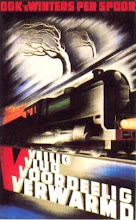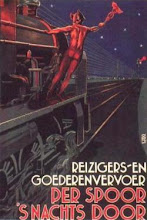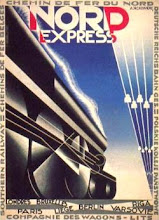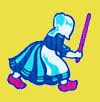Last week on the model train swap meeting in Houten, I acquired an old electrical engine made by the Bing Brothers in the roaring twenties, so now roughly 90 years old. It just mentions 18 V on the side, has a body that is brown lithographed with yellow stripes. It was more difficult than expected to find some information on this little engine on Internet, presumably because the name interferes with a now semi-popular search engine. Additionally, Bing apparently did not number its products like Märklin or Lionel did.
Nevertheless, I found two hits on the web, one in historytoy and one in German image gallery of stuff that once was on Ebay. On Historytoy it is named "Elektrolok 22". When I compare the pictures with the engine that I obtained, I notice that some previous owner has replaced the third rail pick-up assembly, but that for the rest the engine is complete; all the buffers, pantographs, box journals, etc. are there.
The engine did not run properly, tough; it created a lot of noise, vibrations and ozone. So, it was time for thorough inspection. The engine disassembles easily with the two screws and nuts that fastens the body to the black chassis. Then the black chassis can be removed from the central motor block with again two screws and nuts. I removed the red spoke wheels with a wheel puller and then the engine could be completely dissembled in its components.
On the photo above it is from left to right, the wire to front-light, the connectors for passenger cars lights, the top motor-block piece, the E-unit (reversing unit, in Bing terms the Fahrrichtungsumschalter), the stator coil, the bottom motor piece and the third rail assembly. I reckoned that nobody every opened this motor in 90 years time and that I had to remove the lot of hardened lubricant, carbon black and dust.
The E-unit drum was filthy and did not easily rotate, so I cleaned it with a Dremel tool with a brass wire brush and the lubricated the E-unit-axle.
I noticed that the wires were still cotton insulated and crumbly, so I removed them all and soldered new wires on. Furthermore, I found a short in the wire from the third rail pick-up to the stator coil. It missed its insulation at the position were it ran through the bottom of the bottom-motor-block.
So, that was an easy fix as well. Then I cleaned years of carbon dirt from the 3 pole commutator. I measured the stator coil: 3 Ohm. That is reasonably for an old coil. Then I measured the resistance between the 3 commutator plates: all 2.6 - 2.7 Ohm, so also reasonable. I reassembled the engine and with some wiggling it started to run fast. It is a fast spinner for a 90 year old electrical engine. So, now it is time to clean the large gear wheels and the red spoke wheels. Then I better repaint them bright red.
Above the front side of the cleaned engine with left the E-unit and right the green stator coil.
The back side, shows a bit of the E-unit on the right side. It is a electro-mechanical system, A hooked lever is moved by the stator coil and hooks in a gear with 4 teeth. Every time the current is engaged, the lever is pulled to the stator and the hooked lever rotates the E-unit drum for 90 degrees. Fairly smart stuff for the twenties.
Sunday, September 02, 2018
Subscribe to:
Comments (Atom)














